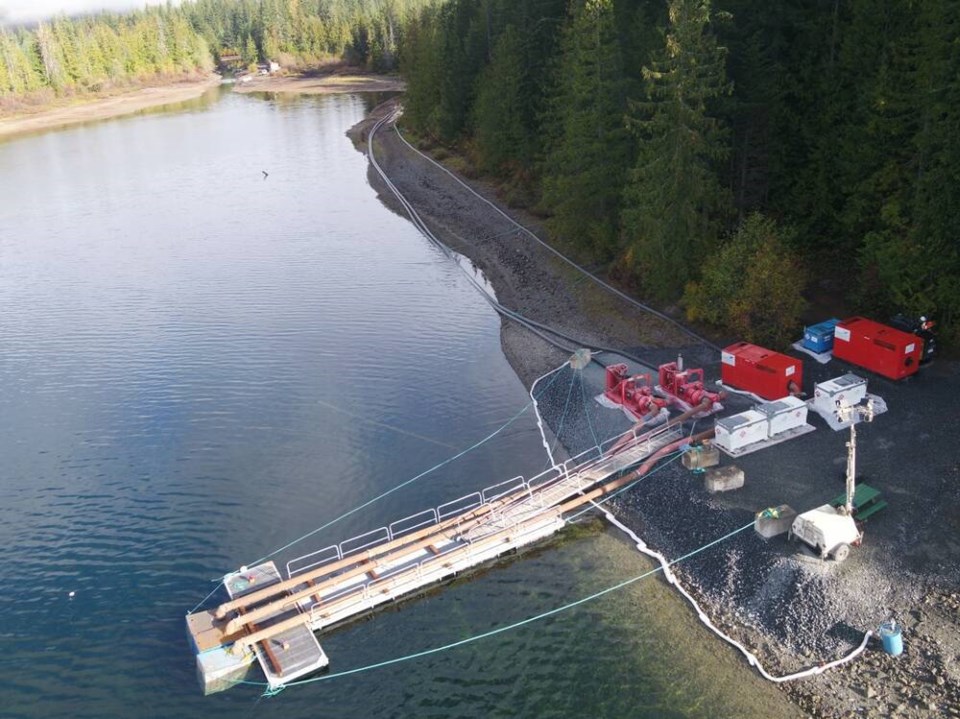Thousands of salmon are fighting their way up B.C. rivers to spawn now that desperately needed rain and cooler temperatures have finally arrived after a months-long drought.
But still more rain is needed to create optimum spawning conditions, say scientists and river watchers, who are pinning their hopes on rain that’s expected to arrive Thursday on the east coast of central Vancouver Island.
The drought has killed thousands of salmon arriving at their home rivers to spawn. Graphic images from the central coast on the mainland showed pink salmon piled on top of each other that had died before they had a chance to spawn.
Many salmon on Vancouver Island and elsewhere on the coast had been waiting for rains to fill rivers to make them passable and deep enough to allow spawning. The longer the fish spend in marine waters, the poorer their condition and the less likely they are to successfully spawn.
Peter McCully, Goldstream Hatchery technical advisor, said Wednesday that water released by Capital Regional District reservoirs starting Oct. 28, along with recent rains, has helped mitigate drought impacts, and fish have started swimming into the Goldstream River.
“I’m still cautious, but things are looking a lot more positive now than they were a couple of weeks ago.”
A total of 5,842 chum salmon — the major species in Goldstream — had been counted in the river as of Wednesday, and they are just starting to spawn, he said.
“These fish are fresh. They have just come in with the precipitation and the release of water.”
The run normally peaks about Nov. 12, but chum numbers are already above those last fall, when about 4,000 returned, McCully said.
This year, Fisheries and Oeans Canada has forecast a return of 25,000 to 30,000 chum, said McCully, who expects the number will be somewhat lower.
Next to spawn at Goldstream will be coho salmon, a total of 258 of which have been counted in the river, “which for this time of year is really good,” McCully said.
Farther north on Vancouver Island, the Cowichan River is now faring better thanks to recent rains, said Tom Rutherford of the Cowichan Watershed Society.
Cowichan River salmon have benefited from water stored earlier this year in a weir — although when the rain began, the river was just about at the stage where it could not support recommended flows of seven cubic metres per second, he said.
“So we were just at the end of our tether and it started to rain — so a good news story.”
As of Oct. 28, 9,000 chinook had passed the river’s counting fence, well above Fisheries and Oceans’ target of 6,500, he said.
“And the fish are continuing to come now that we have water in the river. So I think we are looking at quite a good year with respect to chinook again.”
On top of the 9,000 adult chinook, another 2,000 jacks — two-year-old chinook capable of spawning — are also in the river. “They are generally a forecast of what’s coming next year, so it is nice to see a healthy population of jacks coming back,” Rutherford said.
It’s too soon to say how many coho will return, but so far it looks good, he said. “By far, the majority of the run is still coming in.”
He said the chum run does not look good so far, but it’s still early days and could pick up.
B.C. Hydro spokesman Stephen Watson said rainfall amounts have been high on the Island’s west side, “but we are seeing far less rainfall” on the east side. One problem is the rainshadow effect, where rain is blocked from falling, sometimes by formations such as mountains
The amount of water flowing into fresh-water systems on the east side has improved, but levels are still low, Watson said. “But really when you consider how low the reservoir levels are, that is really the issue.”
The Puntledge River system, which is below the Comox Lake reservoir, is supposed to have a minimum fish habitat flow of 16 cubic metres per second. It had dropped as low as seven cubic metres per second, but moved up to nine cubic metres per second on Monday. The plan was to move it up to 11 cubic metres per second on Thursday.
“We are slowly moving in the right direction and we will see what happens with this Thursday-Friday storm,” Watson said.
With the very low level of the Comox Lake reservoir, however, the water flow may be held at 11 cubic metres per second, he said.
The last time the Puntledge river flow was this low was in November 2002, 20 years ago, Watson said.
On the larger Campbell River system, it has been 29 years since flows have been as low as this year.
While the target flow at this time of year for chinook and coho is 100 metres per second, the river system has had a 65-cubic-metre-per-second flow rate for some time, although coming rains might make a difference, Watson said.
The riverbed is fully covered at 80 cubic metres per second.
B.C. Hydro installed pumps on the Upper Quinsam River nearly two weeks ago, but there has been little change in water levels, Watson said. Pumping may stop on Thursday because of the rain, but the pumps will stay in place in case they are needed.
On the Island’s east side, the Ash River and Jordan River are both in good shape, he said.




